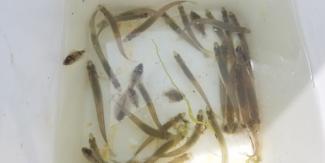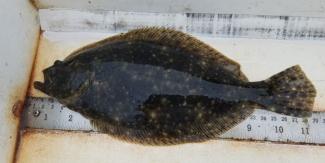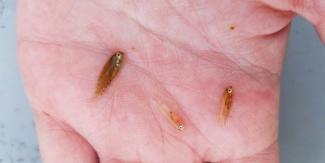Narragansett Bay Juvenile Finfish Seine Survey
Background
The RI Narragansett Bay juvenile finfish survey began in 1988. The purpose is to monitor the relative abundance and distribution of the juvenile life history stage of commercial and recreationally important species within Narragansett Bay. The data collected is used in stock assessments, development of Fishery Management Plans, evaluating changes in juvenile population dynamics, and to characterize and map essential juvenile finfish habitat within the bay.
Survey Design
The survey encompasses 18 fixed stations within Narragansett Bay. The survey began with 15 stations in 1988, with 3 additional stations added in 1990 (Dyer Island, 16), 1993 (Warren River 17), and 1995 (Wickford 18).
Survey Gear
Finfish are collected using a 200 foot by 10 foot 1/4 inch mesh beach seine. The seine has a buoyed float line and a weighted footrope.
Sampling Methods
The beach seine is set in a semi-circle, away from the shoreline and back again using an outboard powered 22' boat. The net is then hauled toward the beach by hand and the contents emptied into a large water filled bucket. Area swept of the net is calculated to be, on average, 5,837 sq ft.
Physical measurements, such as weather conditions, water temperature, dissolved oxygen, and salinity are taken at each station. Fish are sorted by species, measured, and counted. If more than 50 of a single species are collected, a sub-sample is taken. The sub-sampled is then measured and counted. Fish are released immediately after measurements are taken. Relative abundances of invertebrates and aquatic vegetation are also noted.
Sampling Frequency
Finfish are sampled monthly at all 18 stations from June through October of each year.
Sampling Locations:

For more information about the survey please contact Anna Gerber-Williams




